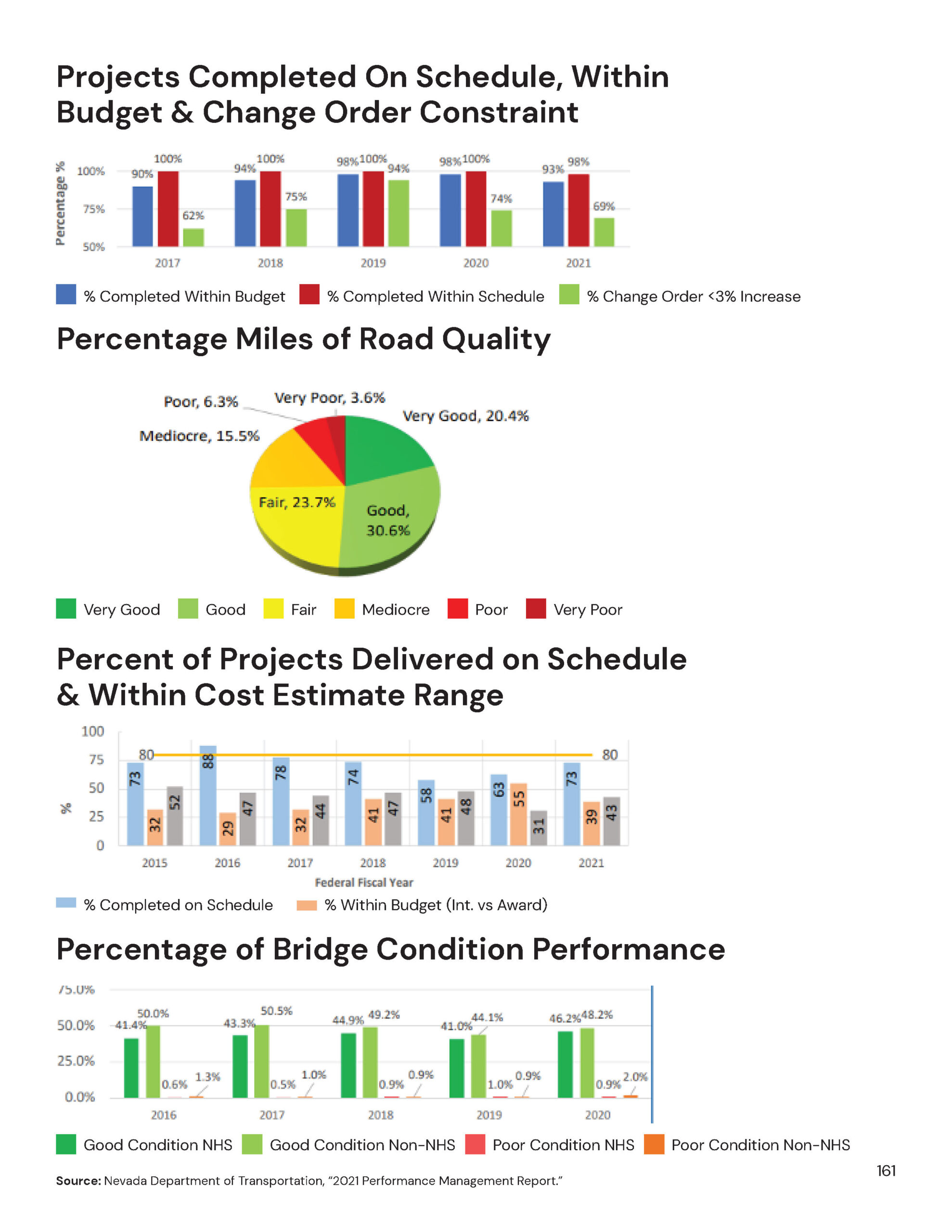Highway Quality
The Nevada Department of Transportation (NDOT) is responsible for building and maintaining public highways in the Silver State and oversees about 84,277 lane miles.1
To accomplish this mission, NDOT receives funding from federal grants and state highway user funds that are generated primarily from taxes on motor fuels. For the 2023-2025 biennium, lawmakers approved a total of $1.932 billion in funding for NDOT, including $840.5 million from federal sources and $936 million out of the state highway fund.
Key Points
The condition of Nevada’s roads are among the best in the nation. Based on pavement quality, Nevada interstates rank second- and 13th-highest in the nation in rural and urban settings, respectively. Arterial routes rank even higher, at first- and 12th highest for rural and urban settings, respectively. Nevada also boasts the second-lowest percentage of deficient bridges nationwide. Nevada ranks 11th in urbanized congestion.
However, Nevada ranks poorly in highway fatality rates, at 32nd in urban areas and 48th in rural areas. Nevada also ranks poorly in administrative disbursements per mile, at 47th.2
Nevada’s urban interstates have been upgraded to avoid congestion. In 2014, Nevada was ranked as having the sixth-most congested urban interstates in the nation. By 2023, Nevada had improved to 11th among the states for avoiding urban congestion, with the average motorist losing 7.28 hours per year to urban congestion. This compares favorably to the national average of 23.83 hours lost to urban congestion.3
Nevadans face above-average costs per state-controlled highway mile. Nevada taxpayers spent $90,048 per state-controlled highway mile in 2019 including all administrative and maintenance costs – 31st highest in the nation. This amount is slightly above the national average of $83,714. This relatively high cost was underscored by high administrative costs. At $13,614 per lane-mile, administrative costs were more than double the national average of $5,342.4
Recommendations
Install High-Occupancy Toll (HOT) lanes to parallel congested urban interstates. HOT lanes are limited-access lanes reserved for high occupancy vehicles but open to motorists who elect to pay a toll in order to access these lanes. Toll rates are managed electronically and subject to variable pricing in order to control the volume of traffic on HOT lanes. During hours of peak traffic when the lane demand increases, so does the price of accessing HOT lanes.
The HOT lane concept was developed by the Reason Foundation in 1993 and subsequently endorsed by the Federal Highway Administration.5 HOT lanes now in operation in California, Colorado, Minnesota, Texas and Utah have proven tremendously effective at using the power of markets to control traffic volume and alleviate urban congestion.
Pass a Community Transportation Corporation Act. Lawmakers can address the state’s need for urban highway development even during periods of stagnant revenue growth by allowing the private sector to develop additional highway capacity. Model legislation from the American Legislative Exchange Council would allow the establishment of non-profit corporations to issue revenue bonds and build highways and infrastructure for public use.6
Streamline operations at the Department of Transportation. While NDOT has consistently kept Nevada atop the quality rankings for state highway systems, the department is also responsible for saddling taxpayers with relatively high administrative costs. Lawmakers should direct NDOT to submit to an independent performance audit in order to determine how administrative costs can best be reduced.

1 Nevada Department of Transportation, 2021 Lane Miles.
2 Baruch Feigenbaum et al., “Annual Highway Report: Ranking Each State’s Highway Conditions and Cost-Effectiveness, 2023.
3 Ibid.
4 Ibid.
5 Gordon Fielding & Daniel Klein, “High Occupancy/Toll Lanes: Phasing in Congestion Pricing a Lane at a Time,” Reason Foundation Policy Study No. 170, 1993.
6 American Legislative Exchange Council, “Community Transportation Corporation Act, 2003.
7 See “Structural Reform: Auditing.”
